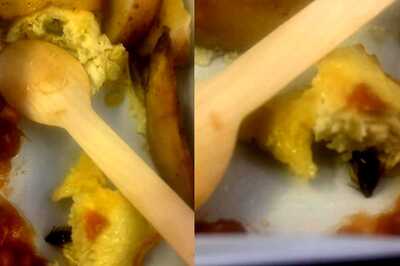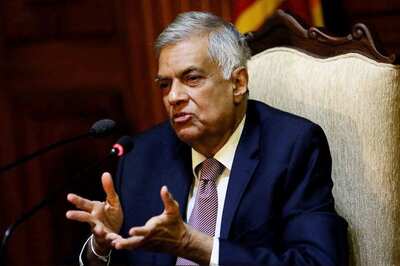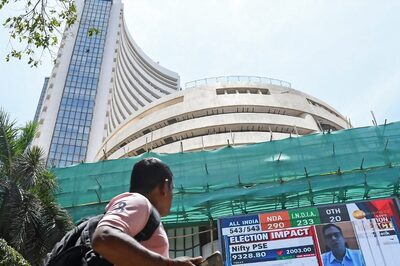
views
Sriharikota: India's first lunar spacecraft Chandrayaan-1 started to cruise around the earth in its designated orbit Wednesday morning, minutes after a copybook liftoff launched the country into the elite club that has sent missions to the moon.
Other members of the club are the US, former Soviet Union, European Space Agency, China and Japan. The US returns to lunar exploration aboard Chandrayaan-1, which is carrying two NASA instruments in its payload.
Speaking minutes after the successful liftoff from this spaceport off the Andhra Pradesh coast, about 80 km north of Chennai, Chairman of the Indian Space Research Agency (ISRO) G Madhavan Nair described the moment as "historic. India has started its journey to the moon. The first leg has gone perfectly. the spacecraft has been launched into orbit."
The 44.4-metre-tall 316-tonne rocket, Polar Satellite Launch Vehicle (PSLV C11), had a copybook launch at 0620 hrs (IST) and completed its mission by placing the lunar orbiter Chandrayaan-1 into its scheduled orbit around the earth within 18 minutes, just as planned.
Nair pointed out that the launch had gone off perfectly despite heavy rain in and around the spaceport for the last four days. "We've been fighting the odds for the last four days," he said. But the weather gods relented by Tuesday evening and there no rain when the launch took place in a cloudy morning sky.
Chandrayaan-1 started to orbit the earth on its geostationary transfer orbit (GTO), from which its onboard liquid apogee motor (LAM) will be fired in a series of complex manoeuvres to take it to the lunar orbit - 387,000 km from earth - Nov 8.
It was a dream come true for about 1,000 space scientists and technologists when PSLV-C11, with the spacecraft atop, blasted off from the Satish Dhawan Space Centre of the state-run ISRO.
Within minutes of the 44.4-metre rocket roaring aloft, leaving behind an inferno in the underground inlets of the second launch pad, the mission control centre of the space station erupted with joy and excitement.
Top scientists, led by Nair, space centre director M.C. Dathan, associate director M.Y.S. Prasad and others shook hands and hugged one another even as the high-security facility reverberated with clapping of hands and cheers.
Former ISRO chairmen U.R. Rao and K. Kasturirangan and space commission member Roddam Narasimaiah, who were present on the occasion, congratulated Nair and his team.
Prominent dignitaries who witnessed the historic mission from ground zero included Tamil Nadu governor Surjit Singh Barnala and Minister of State for Housing and Urban Poverty Alleviation Kumari Selja.
Once the 1,380-kg Chandrayaan-1 gets near the moon its speed will be reduced to enable the gravity of the moon to capture it into an elliptical orbit.
At the earliest possible opportunity the spacecraft that will orbit 100 km above the surface of the moon will drop its Moon Impact Probe (MIP) which will land on the lunar surface carrying India's flag, among many scientific instruments. After that, the spacecraft will also activate its cameras and other instruments on board.
Chandrayaan-1 will orbit the moon for two years. It carries 11 experimental payloads, five Indian and six from abroad - the two from NASA, three from the European Space Agency (ESA) and one from the Bulgarian Academy of Sciences.
The objectives of the mission are to expand scientific knowledge about the moon, to upgrade India's technological capability and provide opportunities for planetary research to the younger generation of scientists and technologists.
"Chandrayaan-1 aims to achieve these objectives through high resolution of the moon in the visible, near infrared, microwave and x-ray regions of the electromagnetic spectrum," mission director M. Annadurai told IANS.
A three-dimensional atlas of the lunar surface and chemical mapping of the entire lunar surface are the other objectives of the mission.
India's mission to the moon is the world's 68th. Of them, 64 have been launched by the US and the former USSR. China and Japan launched their respective moon missions Chang'e and Kaguya in September and October 2007, while the ESA undertook such a mission from November 2004 to September 2006 with SMART (Small Missions for Advanced Research in Technology).
Wednesday morning's launch differed in some important aspects from earlier PSLV launches by ISRO. At liftoff, PSLV C11 weighed 22 tonnes more than the earlier models, as its six strap-on motors were 3.5 metres bigger at 13.5 metres and the rocket carried 12 tonnes of solid propellant as against the usual nine tonnes.
"The vehicle structure was altered to have bigger strap-on motors. The rocket is also padded up with additional thermal insulation," George Koshy, project director, said.




















Comments
0 comment